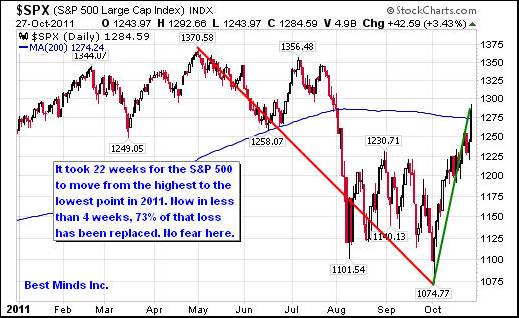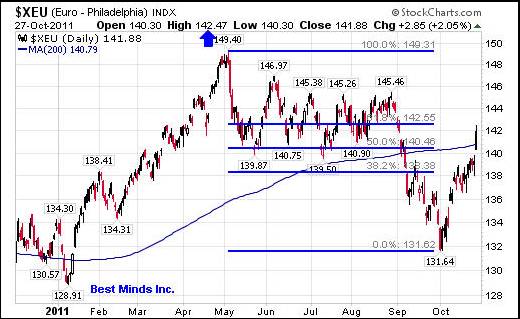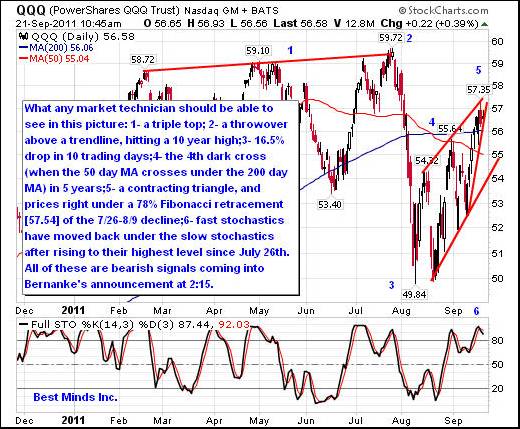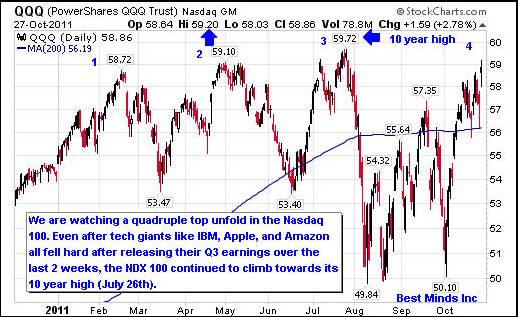Why Stocks Rally Despite Crisis, Darwin’s Deceptive and Dangerous Devices
Stock-Markets / Stock Markets 2011 Oct 28, 2011 - 05:43 AM GMTBy: Doug_Wakefield
 “The film depicts a future in which reality as perceived by most humans is actually a simulated reality created by sentient machines to pacify and subdue the human population, while their bodies' heat and electrical activity are used as an energy source. Upon learning this, computer programmer ‘Neo’ is drawn into a rebellion against the machines, involving other people who have been freed from the ‘dream world’ and into reality.”
“The film depicts a future in which reality as perceived by most humans is actually a simulated reality created by sentient machines to pacify and subdue the human population, while their bodies' heat and electrical activity are used as an energy source. Upon learning this, computer programmer ‘Neo’ is drawn into a rebellion against the machines, involving other people who have been freed from the ‘dream world’ and into reality.”
Comments from Wikipedia regarding the movie, The Matrix
In the last month, investors have read headlines like Europe has six weeks to find debt crisis solution, warns Chancellor George Osborne (Sept 23), In the Absence of a Credible Plan we will have a Global Financial Meltdown in Two to Three Weeks, [states] IMF Advisor (Oct 6), and G20 Tells Eurozone to fix debt crisis in 8 days (Oct 16). As I release this article, a headline reads, S&P 500 Extends Best Month Since ’74, Euro Rises on Debt Accord, proving that the deal completed last night in Europe was “a success”. The worst is now behind us. I guess the “crisis” was all just hype, right?


Yet, questions still come to mind. “How can the Euro and stock indices in the US and Europe rally so sharply in 18 trading days with such news background? Are ‘investors’ optimistic or crazy? Did investment managers always believe that ‘the solution’ was always going to come through, and that smooth sailing is now ahead for Europe and global markets”? The simple answer may not be one you think about day to day when looking at markets, but the data proves it is at the core of all rising and falling prices across our markets, and it has no emotions; the computer. Without extremely powerful and fast computers, the world we have seen unfold over the last few years could never have taken place.
In my September 21st article, Peeling Onions, I stated that “This article is the first in a series on peeling back layers of false concepts in our minds that millions of investors have been indoctrinated to believe since the 1980s. Since these ideas allow us to explain our world in a much more controlled fashion, they allow us to live in our own bubble world.” In this second article, we will continue along this same theme; the topic, extremely fast computers that make more than 50% of the stock trades that happen daily in U.S. markets. As we examine various sources of data and comments by various experts, each of us must decide if the financial markets of 2011 operate the same way as the financial markets of 1991 of even 2001. Are these tools helping foster an environment where more power is placed in fewer hands, thus evolving more into Darwin’s “survival of the fittest”, or do these tools reveal financial markets are moving back toward the idea that “all men are created equal”? When the crowd is winning, these are just philosophical questions. When the crowd is losing, these questions become extremely pertinent to their own personal plans and lives.
The Order in the New World
If we were to visit the New York Stock Exchange website, we could learn that this institution, like many institutions in our world today, is one with a very long history.
“On May 17, 1792, twenty-four stockbrokers gathered outside 68 Wall Street under a buttonwood tree to sign an agreement that would establish the rules for buying and selling bonds and shares of companies. The Buttonwood Agreement, as it is known, is so named because the tree served as the regular meeting place for these pioneers of Wall Street. The signers of the Buttonwood Agreement drafted their first constitution on March 8th, 1817, and named their nascent organization the New York Stock & Exchange Board.”
The NYSE exchange stayed the NYSE until 2006, when it merged with Archipelago Holdings (acquired the Pacific Stock Exchange in 2005) to form the NYSE Group, which subsequently merged with Euronext (who went public in 2001 after merging the Paris, Brussels, Amsterdam exchanges in 2000 and acquiring the London Financial Futures and Options Exchange, and the Lisbon Exchange in 2002) in 2007. Even in 2011, the “global financial marketplace group”, continues to change form:
NYSE Shareholders Approve Merger With Deutsche Boerse, Futures Mag.com, July 7, ‘11
“NYSE Euronext (NYSE: NYX) today announced that its shareholders have approved the adoption of the business combination agreement with Deutsche Boerse (XETRA:DB1) and related proposals.”
NYSE CEO: EU Regulations To Ease Competitive Concerns on Deutsche Deal, Wall Street Journal, Oct 24 ‘11
“NYSE Euronext (NYX) and Deutsche Boerse AG (DB1.XE, DBOEF) aim to sell their proposed merger to European Union regulators as a deal that will make the region more competitive on the world stage and a safer place to invest and hedge risk, according to the top executive of NYSE Euronext.”
I believe we could all agree that things have changed dramatically, not only a great deal from its founding days in 1792, but in the previous decade alone. As the largest global conglomerate in financial markets continues to morph, so also do the requirements of “the customers” of the exchange. The next comments can be heard (or read) in the report released by 60 Minutes on June 5, ’11, Wall Street: The Speed Traders.
“For 150 years, the floor of the New York Stock Exchange was the center of the financial world, the economic engine that helped American business raise capital and create jobs.
Today it is still the public façade of Wall Street, and a television backdrop for reporters relaying financial news. But less than 30 percent of the trading is conducted there now, and the specialists and the noise of the floor is being replaced by the speed and quiet efficiency of computers, and the action has moved elsewhere.”
The images in our minds continue to be ones millions chose to believe when investing for their future. We place our funds in the capital markets, and these funds go into businesses that grow, and as they grow, they create more jobs, and more jobs means more spending, and thus our investments increase in value. However, it is obvious, that the dominant force behind price movements, both up and down, are driven more and more by ever faster computers rather than humans pondering whether their decisions are good investments to hold and increase, or poor ones to sell.
“Most people don't know it, but the majority of the stock trades in the United States are no longer being made by human beings. They're being made by robot computers, capable of buying and selling thousands of different securities in the time it takes you to blink an eye.
These supercomputers - which actually decide which stocks to buy and sell - are operating on highly secret instructions programmed into them by math wizards, who may or may not know anything about the value of the companies that are being traded.
It's known as "high frequency trading," a phenomenon that's swept over much of Wall Street in the past few years and played a supporting role in the mini market crash last spring that saw the Dow Jones Industrial Average plunge 600 points in 15 minutes.” [Wall Street: The Speed Traders, 60 Minutes, June 5 ‘11]
As a specific example of how high frequency trading differs from the average investor at a brokerage firm, we turn to Manoj Narang, owner of Tradeworx, the only firm willing to be interviewed by 60 minutes:
“…Narang told correspondent Steve Kroft, "Humans are not involved in the trading because humans are way too slow to trade on the kinds of opportunities that we're trying to capture. We're trying to capture opportunities that exist for only fractions of a second."
The Tradeworx computers don't care where a stock is going to be trading next year, next month, next week or even tomorrow, because they are going to be in and out of it on the same day, in a matter of minutes.” [Ibid]
What no one outside the world of trading can grasp, is that picking up pennies can be extremely profitable.
“What Narang and other high frequency traders tell their computers to do is to make a profit of a penny or less, 40 million times day….
Asked how successful he and his firm have been, Narang told Kroft, ‘We've had two or three days in a row where we lose money. But we've never had a week, so far, where we lost. We've never had a month that was a loser for us.’” [Ibid]
If this sound unbelievable, consider these points I pulled from Welcome to the Machine: High Frequency Trading Domination, an article released on Oct 17 ’11 written by Liz Ann Sonders, Chief Investment Strategist at Charles Schwab:
- Trading speeds are measured in milliseconds (thousandths of a second), and even more recently in microseconds (millionths of a second) and nanoseconds (billionths of a second).
- HFT firms are usually trading their own capital and rarely hold positions overnight.
- According to several sources, including TABB Group, Aite Group and Thomson Reuters, HFT now accounts for between 55-75% of trading volume on average, with some days even higher.
- On August 8, the Monday after S&P downgraded US debt, the Dow Jones Industrial Average fell by 635 points. Volume on the New York Stock Exchange was the fourth highest on record. TABB estimates record profits of $60 million that day for HFT firms.
Now chew on this idea. When we read news headlines that state that investors bought or sold certain markets for some specific reason explained in a news article, and yet the majority of the trades on the largest exchanges in the world are electronic and can react to changes almost instantaneously, are we really watching a crowd of investors reacting to the latest news, or computers reacting to changing math patterns? When world leaders come out with “the solution”, and the markets move up or down within minutes, was this a reflection of a group of traders waiting to “hit the button” or the quiet hum of massive computers looking for changes in math patterns in the markets that cause their algorithms to send out trades in milliseconds once “the event” triggered a change in price in a stock, stock market, or even the largest currencies in the world? The significance of these questions is enormous, and changes not only the way we must look at financial markets, but our own personal futures.
Bring in the Big Guns
On Friday, Oct 14th, according to the Financial Times article, Regulators plan coordinated HFT monitoring, the UK FSA and the US SEC hosted a roundtable discussion in London with 40 officials representing 16 countries in an effort to develop a plan to monitor high speed trading. After the meeting, Mary Schapiro, chairman of the SEC, stated that “the meeting was a tremendous success in advancing such cooperation on market structure issues”, and that the HFT issue is “increasingly vital in ensuring the safety and soundness of our markets and protecting investors”. When one reviews the opening remarks found in the U.S. SEC (Securities and Exchange Commission) and U.S. CFTC (Commodities Futures Trading Commission) Preliminary Findings Regarding the Market Events of May 6, 2010 (i.e. the flash crash) released on May 18, 2010, and then considers the enormous volatility in world markets since July, it is amazing the parallel in world events. It is as though someone hit “instant replay”, only this time, the image was “of course they will fix this problem” as equity markets had rallied 17 days before today’s “crisis is solved” rally - assisted by fast speed computers in the futures markets last night before stock exchanges opened in Europe and New York this morning.
“May 6 [2010] started with unsettling political and economic news from overseas concerning the European debt crisis that led to growing uncertainty in the financial markets. Increased uncertainty during the day is corroborated by various market data: high volatility; a flight to quality among investors; and the increase in premiums for buying protection against default by the Greek government. This led to a significant, but not extraordinary, down day in early trading for the securities and futures markets.
Beginning shortly after 2:30 p.m., however, this overall decline in the financial markets suddenly accelerated. Within a matter of a few minutes, there was an additional decline of more than five percent in both the equity and futures markets. This rapid decline was followed by a similarly rapid recovery. This extreme volatility in the markets suggests the occurrence of a temporary breakdown in the supply of liquidity across the markets.
The decline and rebound of prices in major market indexes and individual securities on May 6 was unprecedented in its speed and scope.”[Italics mine]
If financial regulators did not have enough on their plate already, as they seek to
monitor these lightning trading storms occurring daily around the globe, it would appear that there is yet another risk that was far off the radar screen during the recent “fix the European debt crisis” rally. According to an Aug 20 ’11 article in The Australian News, Pentagon Prepares for Economic Warfare, another “first ever” event took place during the last few years, and must be considered by all individuals concerned with the “risk on” trade.
“The guests were assembled in the Warfare Analysis Laboratory, surrounded by uniformed officers from the highest levels of the Pentagon and a dizzying array of screens normally used to simulate nuclear world war.
The gentlemen were called to order and the games began.
‘If you imagine the war room in Dr. Strangelove, you're not far off,’ says participant James Rickards.
Yet this was no traditional battle game, but rather the Pentagon's first economic war game, and the authorities are loath to talk about it….
Rickards is not a soldier but a banker. He was joined in the war game by dozens of his Wall Street colleagues, flown in from Manhattan to this bunker at the Applied Physics Laboratory in Maryland for the two-day event in 2009, when the Pentagon started to get really alarmed….[italics mine]
Once again, this is a systemic level of risk none of us even want to consider.
“They were sent into ‘bunker rooms’ and told to use financial or economic tools - currency, debt, stocks, gold - to bring their enemies to their knees. Everything was conducted via computer, and they could be as devious and ruthless as they liked….
Paul Bracken is a professor and expert in private equity at the Yale School of Management who serves on government advisory committees at the US Department of Defense. He was one of the key players behind the 2009 economic war game, and the smaller versions that have been played out since.
‘The atmosphere that day was one of surprise at the magnitude of the threat,’ he says.
‘The Pentagon people were used to dealing in terms of military battles: how many ships, how many missiles. This opened up whole new strategies.’”
As we consider the ability of computers to produce what is now very close to a quadruple top in the NDX 100 as we continue through Q3 earnings, is it really beneficial to pick up pennies daily, when computers can also generate the same emotional swing among traders and investors today that slammed those caught up by the South Sea Bubble almost 300 years ago? Maybe “risk on- risk off” is not a new trading terminology after all.

[Chart from Sept 21st article, Peeling Onions]

“Alexander Pope, writing to Bishop Atterbury on 23 September (the bubble popped in August 1720), had finally decided where he stood on the subject of the South Sea (Co). Gone was the ebullient speculator of the New Year to be replaced by the autumnal moralist, intoning in classical style against the vices of the age:
‘The fate of the South- sea Scheme has much sooner than I expected verify’d what you told me. Most people thought it wou’d come, but no man prepar’d for it, no man consider’d it would come like a Thief in the night, exactly as it happens in the case of death….They have dreamed out their dreams and awakening have found nothing in their hands.’ [Devil Take the Hindmost: A History of Financial Speculation (1999) Edward Chancellor, pg 84]
If you are interested in our most comprehensive research and trading commentary, consider a subscription to The Investor's Mind: Anticipating Trends through the Lens of History.
Doug Wakefield
President
Best Minds Inc., a Registered Investment Advisor
2548 Lillian Miller Parkway
Suite 110
Denton, Texas 76210
www.bestmindsinc.com
doug@bestmindsinc.com
Phone - (940) 591 - 3000
Alt - (800) 488 - 2084
Fax - (940) 591 –3006
Copyright © 2005-2011 Best Minds Inc.
Best Minds, Inc is a registered investment advisor that looks to the best minds in the world of finance and economics to seek a direction for our clients. To be a true advocate to our clients, we have found it necessary to go well beyond the norms in financial planning today. We are avid readers. In our study of the markets, we research general history, financial and economic history, fundamental and technical analysis, and mass and individual psychology.
Disclaimer: Nothing in this communiqué should be construed as advice to buy, sell, hold, or sell short. The safest action is to constantly increase one's knowledge of the money game. To accept the conventional wisdom about the world of money, without a thorough examination of how that "wisdom" has stood over time, is to take unnecessary risk. Best Minds, Inc. seeks advice from a wide variety of individuals, and at any time may or may not agree with those individual's advice. Challenging one's thinking is the only way to come to firm conclusions.
Doug Wakefield Archive |
© 2005-2022 http://www.MarketOracle.co.uk - The Market Oracle is a FREE Daily Financial Markets Analysis & Forecasting online publication.



